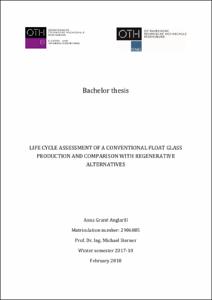Mostra el registre d'ítem simple
Life cycle assessment of a conventional float glass production and comparison with regenerative alternatives
| dc.contributor | Sterner, Michael |
| dc.contributor.author | Grané Anglarill, Anna |
| dc.date.accessioned | 2018-08-03T08:20:03Z |
| dc.date.available | 2018-08-03T08:20:03Z |
| dc.date.issued | 2018-01 |
| dc.identifier.uri | http://hdl.handle.net/2117/120519 |
| dc.description.abstract | From a global perspective to a detailed process, this thesis exposes the actual environmental situation and the main factors that condition it. After a quick review of reasons why the situation should change, the study exposes the human activities that cause the greater impacts. This target leads the work to focus on the glass industry because it is part of the energy-intensive manufacture industrial sector. First of all, the life cycle assessment (LCA) is introduced as a tool to analyse the environmental impacts of a product or service. In this thesis, an LCA is carried out to evaluate the production of one tonne float glass. Secondly, the goal and the scope of the LCA are defined. The life cycle of flat glass is contemplated from cradle to gate, which includes the raw material acquisition and the energy and material production. The manufacture phase, which includes the energy and material production, is driven in a comparative manner for different systems: A conventional production system which is mainly powered by natural gas A regenerative production system which is only powered by electricity A regenerative production system which is powered by renewable gas from Power-to-Gas The approach on this LCA is derived from the international standards ISO 14040 and ISO 14044 and its analysis is assisted by the software “Umberto” with the databases “ecoinvent” version 3.3. Thirdly, the product system with its production variations is accurately described in the inventory analysis, where the inputs and outputs of each process are stated and related to the functional unit. This inventory is gathered on the cumulative energy demand and the cumulative raw material demand. Afterwards, the impact categories global warming potential, terrestrial acidification and water, fossil and ozone depletion are assessed and compared between the conventional and the regenerative production systems. At the end, a critical reflection and outlook about the complete process is made. |
| dc.language.iso | eng |
| dc.publisher | Universitat Politècnica de Catalunya |
| dc.rights | Attribution-NonCommercial-ShareAlike 3.0 Spain |
| dc.rights.uri | http://creativecommons.org/licenses/by-nc-sa/3.0/es/ |
| dc.subject | Àrees temàtiques de la UPC::Energies |
| dc.subject.lcsh | Flat glass |
| dc.title | Life cycle assessment of a conventional float glass production and comparison with regenerative alternatives |
| dc.type | Bachelor thesis |
| dc.subject.lemac | Anàlisi del cicle de vida |
| dc.subject.lemac | Vidre -- Anàlisi |
| dc.subject.lemac | Vidre |
| dc.rights.access | Open Access |
| dc.audience.educationlevel | Grau |
| dc.audience.mediator | Escola d'Enginyeria de Barcelona Est |
| dc.audience.degree | GRAU EN ENGINYERIA DE L'ENERGIA (Pla 2009) |


